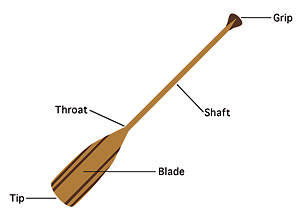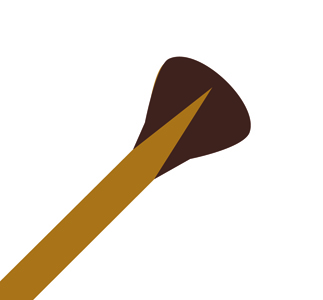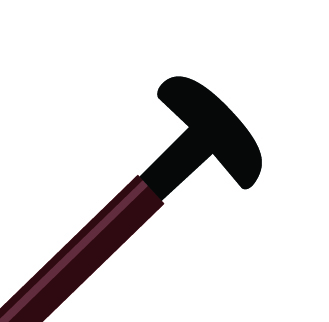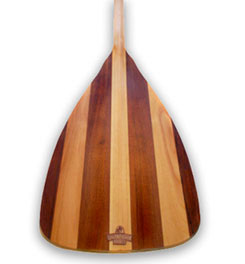
Know your paddle parts.
Now that you’ve got your canoe, you’ll need something to make it go.
Choosing a paddle is bit like a black art, perhaps similar to choosing a hiking boot. Science is a good beginning, but feel makes the final determination.
For a simple piece of gear with relatively few parts, paddles still have numerous options.
Grip
The grip is where it starts. There are T-grips, pear grips, Maine Guide grips, and a couple of variations.
Pear grips are good all-around grips that give fair control in easy whitewater, and are comfortable for long stretches of flatwater.
Asymmetric pear grips are common on bent-shaft paddles where the power face is always on the same side.
T-grips are great for whitewater, as they give a lot of control, but they can be uncomfortable paddling the flats for long stretches.
Maine Guide grips are a unique style that allow for various hand positions.
Whichever grip you choose, make sure it fits your hand well.
 |
 |
|
Pear Grip |
T-Grip |
Shaft
Bent-shaft paddles are designed to be the most efficient at pulling a canoe through the water. Although there are differing amounts of bend, 12 degrees is considered about the best. They are lightweight as compared to most straight shaft paddles which makes using them for hour after hour quite easy.
Using a bent shaft paddle favors a style of paddling called “sit and switch” or the “Minnesota switch.” Every few strokes, paddlers change sides in order to keep the canoe going straight.
Straight shafts still rule for any kind of whitewater, recreational paddling, and tripping. Bent-shaft paddles, because of their bend, make many of the standard canoe strokes difficult or impractical.
Length
It seems as if everyone has a different way of determining paddle length. “Stand on your head with your left knee at a right angle...”
The best way to determine shaft length is to sit or kneel in your boat, immerse your paddle in the water to the top of the blade. The grip should be at your nose level.
On dry land, you can squat or kneel to the approximate height of the seat of your canoe and place the paddle grip on the ground. If you’re close, the throat of the paddle should be about nose height. Bent-shafts will be a little shorter and straight shafts should be a bit longer.
If you’ve done your measuring correctly, your straight shaft will be about two inches longer than your bent-shaft. Playboaters (whitewater junkies) often like slightly longer paddles to power through hard moves.
Blade

Paddle blades come in varying shapes and sizes.
This is really where the rubber meets the road, so to speak. Blades can be long and narrow or short and wide, with a lot of variation in between. The voyageurs who paddled large rivers and lakes, typically used long narrow blades and worked a high cadence. Other blades were developed for certain styles or conditions.
Ottertail paddles (narrow at the tip and wider near the throat) were developed along the theory that the water near the surface was less dense and therefore required more surface area for a consistent pull along the whole blade.
Today, although there are still traditional choices, especially for lakes and deep rivers, a versatile blade will be between seven and eight inches across and about 20 inches long.
Many of the bent-shaft blades taper gradually towards the throat, while whitewater and recreational blades are roughly more rectangular.
Materials
There are solid wood paddles, laminated wood paddles, carbon fiber paddles, and combinations of materials.
Wood has a warm feel in cold weather while synthetic paddles are lightweight and strong.
In whitewater, I like a carbon blade and wood shaft, while for tripping, a solid or laminated wood paddle is my motor of choice.
See Paddle Reviews and Information»
(Illustrations by Sarah Lampe.)

 by Erich Volkstorf
by Erich Volkstorf









